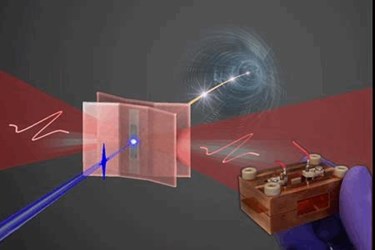MIT Builds Miniature Terahertz-Driven, All-Optical Electron Gun
By Jof Enriquez,
Follow me on Twitter @jofenriq

Researchers at the Massachusetts Institute of Technology (MIT), in collaboration with German scientists, have built a matchbox-sized electron gun that uses laser-generated terahertz radiation (instead of radio frequency fields) to accelerate electrons, while consuming far less power than state-of-the-art electron guns.
Ultrashort electron beams are useful in making atomic-level movies for studying biochemical reactions and phase transitions in metals, semiconductors, and molecular crystals. These beams also can be propelled by electron guns inside particle accelerators to produce ultrashort X-ray sources. However, the achievable resolution of these time-resolved electron diffraction or x-ray experiments has been hindered by surface field and timing jitter limitations in conventional RF guns.
MIT researchers sought to meet these challenges by building a new type of electron gun, which uses laser-generated terahertz radiation — the band of electromagnetic radiation between microwaves and visible light – to excite electrons from rest. While a typical electron gun can be as large as a car, this new device is as small as a matchbox, because the wavelength of the terahertz radiation is much shorter than radio-frequency radiation.
"Electron guns driven by terahertz radiation are miniature and efficient," says main author Dr. W. Ronny Huang from MIT, a researcher at the Center for Free-Electron Laser Science (CFEL) in Hamburg — a cooperation of Deutsches Elektronen-Synchrotron (DESY), the University of Hamburg and the German Max Planck Society — in a news release. "Also, the materials used to guide the radiation are susceptible to much higher fields at terahertz wavelengths as compared to radio frequency wavelengths, allowing terahertz radiation to give a much stronger 'kick' to the electrons. This has the effect of making the electron beams much brighter and shorter."
The device has a nanometer thin film of copper that is targeted by an ultraviolet laser, producing electrons at the opposite side of the thin film. Laser radiation with Terahertz frequency is passed perpendicular to the device and is confined in a microstructure to increase the energy density, and thus, the accelerating power, to almost twice that of current state-of-the-art electron guns.
MIT's electron gun yielded "a peak electron energy approaching 1 keV, accelerated by >300 MV/m THz fields in a micrometer-scale waveguide structure" and achieved "quasi-monoenergetic, sub-kiloelectron volt bunches with 32 fC of charge, which can already be used for time-resolved low-energy electron diffraction," according to the study abstract published in the journal Optica.
"Such ultracompact, easy-to-implement guns — driven by intrinsically synchronized THz pulses that are pumped by an amplified arm of the already-present photoinjector laser — provide a new tool with the potential to transform accelerator-based science," write the researchers.
The new electron gun can be used in a small “linear accelerator” – a protototype of which was described by the same group of researchers in Nature Communications last year – a more affordable alternative to long and large particle accelerators. The ultra-compact terahertz accelerators with extremely short electron bunches hold great potential to have a transformative impact for free electron lasers, linear colliders, ultrafast electron diffraction, X-ray science, and medical therapy with X-rays and electron beams, according to the scientists.
The research group's complementary technologies, the electron gun and the small linear accelerator, are capable of producing electron bursts of a single femtosecond that could generate attosecond X-ray pulses, which would enable real-time imaging of cellular machinery in action.
“We’re building a tool for the chemists, physicists, and biologists who use X-ray light sources or the electron beams directly to do their research,” Huang told MIT News.
